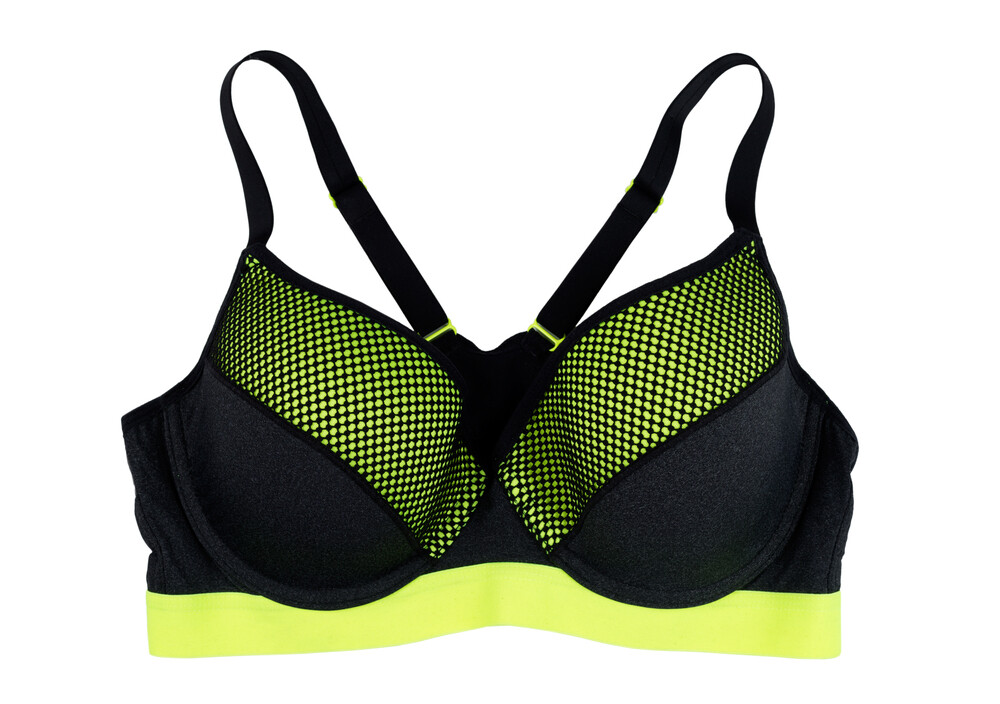When doing sports, a well-fitting bra is at least as important as the right shoes. What do I have to look out for in a sports bra?
Why do I even need a sports bra?
Admittedly, many “must-haves” and trends in the sportswear industry are dispensable. But a well-fitting sports bra is actually just as important as matching running shoes, because the connective tissue of the breast needs support during sports, otherwise it slackens. This also applies to women with small breasts, because when running or jumping the breast moves a few centimetres up and down with every step. This can become painful in the long run. A good sports bra can reduce your own movement by 70 to 80 percent. It also prevents tension in the shoulder and back area, especially in women with large breasts.
How does a sports bra differ from a classic bra?
Normal bras usually have an underwire in the base and are decorated with lace, buttons or frills. This can irritate the skin due to friction during sports. The underwire can also drill through the fabric and injure the skin. “The materials used in lingerie generally do not transport moisture as well to the outside and have a long drying time,” explains Eva Büsel, product manager at the Swiss sportswear manufacturer Odlo. “A cotton bra stays wet forever – so you can easily catch a cold.”
The structure of the bra also differs: “Lingerie bras are designed to look as sexy as possible. Therefore the straps are narrow and not padded. The sides are also quite narrow and taper to the back. This looks nice, but it is not ideal for sports,” says Büsel.
The reason: the pressure from the side provides the most support – and that can only provide a certain width. Narrow straps provide hardly any support and also cut in quickly when moving. Padded bras in particular are uncomfortable to wear during sport because the pads are not perforated and soak up sweat.
How do I find a good sports bra?
For Eva Büsel, the elastic under the breast is one of the most important quality features. “The underbust band should have a good rebound, so after stretching it should return to its original shape. Cheap sellers often save on it, then it quickly wears out.”
The material, functional fibre that dries as quickly as possible, should also have as few seams as possible. Between the breasts, a mesh insert (mesh fabric) is advantageous, because this allows moisture to escape more easily.
The straps are also an important part of the sports bra. Women with large breasts in particular should pay attention to adjustable straps, as the size of the breasts changes slightly during the menstrual cycle.
A high-quality sports bra is usually more expensive than a classic bra because the workmanship is more elaborate and the material is more robust. On the other hand, it provides a pleasant wearing comfort during sports.
When does a sports bra fit correctly?
A sports bra must fit tightly without constricting. There should be no raised neckline and there should be no excess air in the bra cup. The bra should support the bust just below the shoulder blades. As many women wear the wrong bra size – both in everyday life and during sport – you should take the time to get advice and measurements from a specialist shop.
However, it is not the measurements alone that are decisive, but above all how comfortable the bra is to wear. You should therefore always try on a sports bra before buying it, jump in it, stretch your arms upwards and bend over (the underbust band must not slip).
There is also no right or wrong way to cut the bra, because in addition to breast and cup size and chest circumference, factors such as the height of the breast base, shoulder width, the shape of the breast and back muscles and the neck circumference also play a role in determining how the bra fits.
By the way, when we gain or lose weight, the breast grows or shrinks with us. If our weight changes by several kilograms, we should also adjust our bra size.
How do I care for my sports bra?
A sports bra should be washed after every use, because otherwise sweat, deodorant, perfume or creams penetrate deep into the fabric and stick together the functional fibres. Depending on the manufacturer, they are washed at 30 to 60 degrees in the washing machine – preferably in a laundry net.

